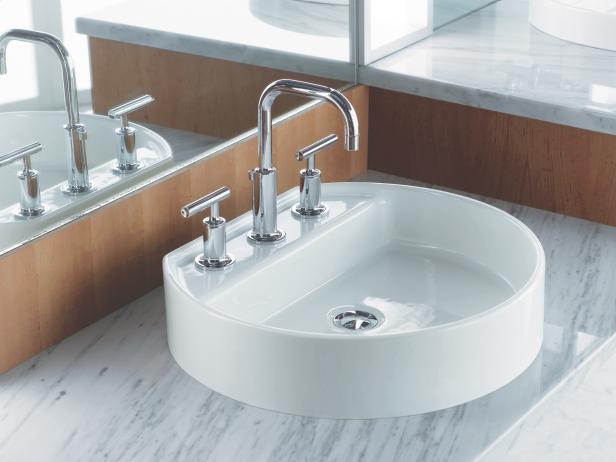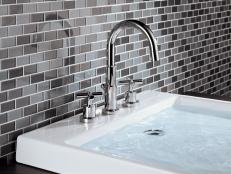Bathroom Sink 101

Bathroom sinks come in a range of possibilities, from simple, functional bowls to complete ensembles with integrated cabinets and countertops. Sometimes called "lavatories," bathroom sinks are a designer's dream, with styles that are quietly practical or wildly artistic, with prices to match.
Sinks come pre-drilled to fit various faucet configurations or undrilled for custom faucet installations.
Sink Materials
Bathroom sinks primarily are made from vitreous china and enameled cast-iron. Sturdy, heavy and durable, sinks made from these time-tested materials are built to last. Other materials include enameled steel, tempered glass, stone, wood, acrylic and solid surface.
China and enameled surfaces come in an array of colors to match most décor. Glass sinks show off swirled and textured surfaces with vivid colors or opaque, smoky whites and blacks. Metal sinks in stainless steel, copper, and bronze feature a variety of finishes, from smooth-as-silk polishes to rustic, hand-hammered textures. Sinks made of acrylic are famously contemporary and neon-colored.
Prices run the budget gamut, starting at $100 and soaring to well over $5,000.
Sink Types
Pedestal sinks have a basin perched atop a long stem or pedestal that rests on the floor. The pedestal conceals the water supply and drain pipes. Because the bowl itself offers little space for items, such as soaps and shaving equipment, compact pedestal sinks are often integrated with cabinets and shelves in half-baths. Their generally graceful appearance makes them a designer's favorite.
Architectural salvage stores are usually well-stocked with older pedestal sinks that feature one-of-a-kind designs at a modest price.
Consoles are sink basins supported by legs. The space between the legs can be fitted with shelves and bars for hanging towels and wash cloths.
Wall-hung sinks are similar to pedestal sinks—without the pedestal. They're mounted directly to wall surfaces and have a contemporary look. Some have decorative shrouds that conceal plumbing pipes. The open space underneath a wall-hung sink is ideal for those in wheelchairs.
Countertop lavatories are low-slung units with shallow bowls. Some sit entirely on top of the counter surface—bowl and all—and some have bowls that extend slightly below the countertop surface. Close cousins include vessel and integrated sinks.
Bathroom Sinks
See All PhotosVessel sinks are decorative bowls that sit on top of the countertop, so the outer surfaces are visually prominent. As part of an overall scheme or a stand-alone statement, vessel sinks are eye-catching centerpieces, and finishes include polished stainless steel, hand-painted porcelain, carved stone and spun glass. Because vessels are tall, they require tall or wall-mounted faucet fixtures.
Integrated sinks have wide, flat edges that are designed to fit flush with countertop materials—typically tile—to provide a smooth transition between the sink and surrounding surfaces. Some are available pre-made from manufacturers of solid surface materials, and a solid surface sink is seamlessly combined into a countertop of various lengths.
Self-rimming sinks are a common sink style with a bowl that fits into a countertop cutout hole, and a rolled rim that rests on the countertop surface and supports the weight of the sink.
Under-counter sinks fit directly under countertop cutout holes and are supported by clips that hold the bowl in place. That means the exposed inside edge of the cutout hole is exposed and must be finished. Under-counter sinks work well with countertops made of stone and solid surface materials.
Vanities are basically sink and faucet arrangements installed on cabinets. As a unit, all components reflect a specific style, such as contemporary, traditional and transitional, and surrounding accessories—shelves, mirrors, etc.—usually are available as parts of a holistic vanity suite. With its furniture DNA, the bathroom vanity becomes a strong design element that sets the tone for the entire bathroom.
Vanities have the illusion of being freestanding pieces, but of course they're tethered to water supply and drain pipes. A vanity usually has drawers, cabinet doors and legs, although some models are wall-hung. Many vanities are compact, which makes them ideal solutions for small baths. Prices range from $300 to $2,500, but custom vanities will cost much more.







































